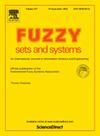Approximability of triangular fuzzified nonlinear T–S fuzzy systems to p-integrable functions based on piecewise linear functions
IF 2.7
1区 数学
Q2 COMPUTER SCIENCE, THEORY & METHODS
引用次数: 0
Abstract
The piecewise linear function (PLF) is an extension of subsection linear function with one variable on Euclidean space, and it plays an important bridging role in characterizing the relationship between the fuzzy systems and the approximated function. In this article, the determinant linear expression of PLF is introduced by subdividing the input space of p-integral functions and solving linear equations systems, and analyzes and represents the vertex coordinates of these small polyhedrons obtained after subdivision through geometric methods. A triangular fuzzified nonlinear Takagi Sugeno (TFNL T–S) fuzzy system is established by introducing the fuzzy rules of the nonlinear output and the determinant coefficients of PLF, and it was proved through the p-integral norm and matrix norm that TFNL T–S fuzzy system has approximation performance for p-integrable functions when all parameters of a linear part in the consequents of the rules take non-zero constants. Finally, the numerical simulations were conducted on the approximation performance of TFNL T–S fuzzy systems through simulation examples. The results show that the proposed TFNL T–S fuzzy system can indeed approximate a given p-integrable function with arbitrary accuracy.
基于分段线性函数的三角模糊化非线性T-S模糊系统对p可积函数的逼近性
分段线性函数(PLF)是一元分段线性函数在欧氏空间上的扩展,它在描述模糊系统与近似函数之间的关系方面起着重要的桥梁作用。本文通过对p积分函数的输入空间进行细分,求解线性方程组,引入PLF的行列式线性表达式,并通过几何方法对细分后得到的这些小多面体的顶点坐标进行分析和表示。通过引入PLF非线性输出和行列式系数的模糊规则,建立了一个三角模糊化非线性Takagi Sugeno (TFNL T-S)模糊系统,并通过p积分范数和矩阵范数证明了当规则结果中线性部分的所有参数均为非零常数时,TFNL T-S模糊系统对p可积函数具有近似性能。最后,通过仿真算例对TFNL T-S模糊系统的逼近性能进行了数值模拟。结果表明,所提出的TFNL T-S模糊系统确实能够以任意精度逼近给定的p可积函数。
本文章由计算机程序翻译,如有差异,请以英文原文为准。
求助全文
约1分钟内获得全文
求助全文
来源期刊

Fuzzy Sets and Systems
数学-计算机:理论方法
CiteScore
6.50
自引率
17.90%
发文量
321
审稿时长
6.1 months
期刊介绍:
Since its launching in 1978, the journal Fuzzy Sets and Systems has been devoted to the international advancement of the theory and application of fuzzy sets and systems. The theory of fuzzy sets now encompasses a well organized corpus of basic notions including (and not restricted to) aggregation operations, a generalized theory of relations, specific measures of information content, a calculus of fuzzy numbers. Fuzzy sets are also the cornerstone of a non-additive uncertainty theory, namely possibility theory, and of a versatile tool for both linguistic and numerical modeling: fuzzy rule-based systems. Numerous works now combine fuzzy concepts with other scientific disciplines as well as modern technologies.
In mathematics fuzzy sets have triggered new research topics in connection with category theory, topology, algebra, analysis. Fuzzy sets are also part of a recent trend in the study of generalized measures and integrals, and are combined with statistical methods. Furthermore, fuzzy sets have strong logical underpinnings in the tradition of many-valued logics.
 求助内容:
求助内容: 应助结果提醒方式:
应助结果提醒方式:


